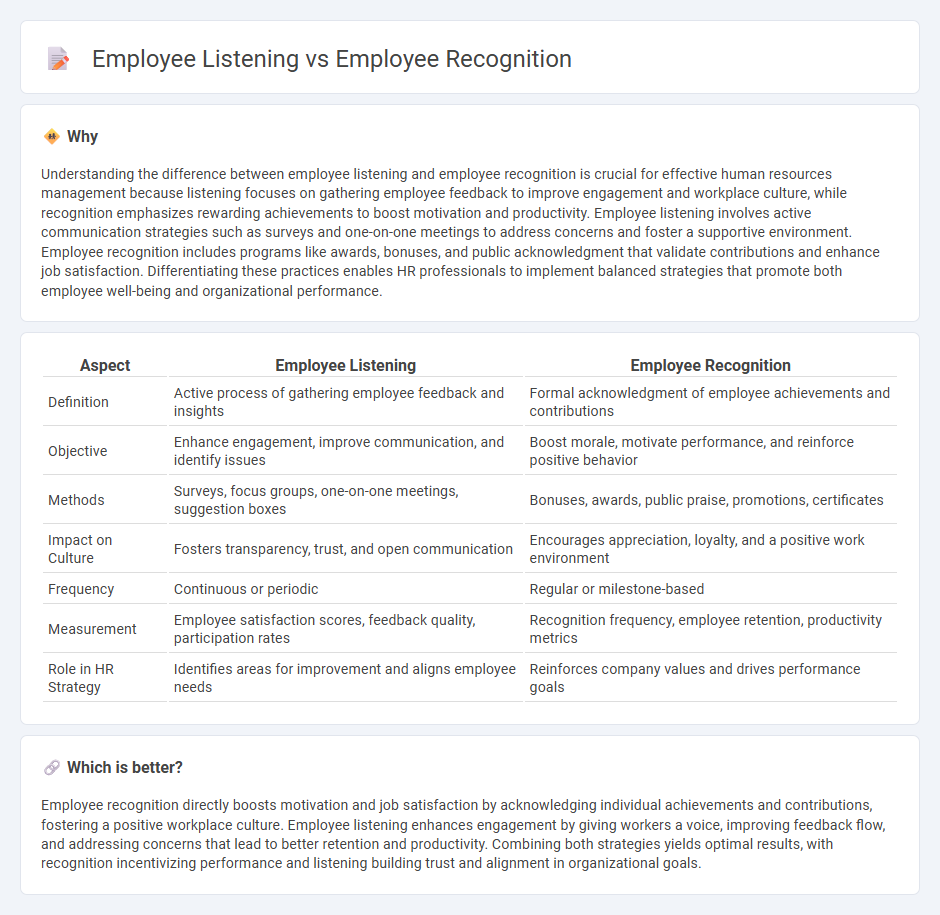
Employee listening involves actively gathering and analyzing feedback to understand workforce needs and improve engagement, while employee recognition focuses on acknowledging and rewarding individual or team achievements to boost morale and motivation. Both strategies are essential for fostering a positive workplace culture and enhancing employee satisfaction and productivity. Explore how integrating employee listening and recognition can transform your HR practices.
Why it is important
Understanding the difference between employee listening and employee recognition is crucial for effective human resources management because listening focuses on gathering employee feedback to improve engagement and workplace culture, while recognition emphasizes rewarding achievements to boost motivation and productivity. Employee listening involves active communication strategies such as surveys and one-on-one meetings to address concerns and foster a supportive environment. Employee recognition includes programs like awards, bonuses, and public acknowledgment that validate contributions and enhance job satisfaction. Differentiating these practices enables HR professionals to implement balanced strategies that promote both employee well-being and organizational performance.
Comparison Table
| Aspect | Employee Listening | Employee Recognition |
|---|---|---|
| Definition | Active process of gathering employee feedback and insights | Formal acknowledgment of employee achievements and contributions |
| Objective | Enhance engagement, improve communication, and identify issues | Boost morale, motivate performance, and reinforce positive behavior |
| Methods | Surveys, focus groups, one-on-one meetings, suggestion boxes | Bonuses, awards, public praise, promotions, certificates |
| Impact on Culture | Fosters transparency, trust, and open communication | Encourages appreciation, loyalty, and a positive work environment |
| Frequency | Continuous or periodic | Regular or milestone-based |
| Measurement | Employee satisfaction scores, feedback quality, participation rates | Recognition frequency, employee retention, productivity metrics |
| Role in HR Strategy | Identifies areas for improvement and aligns employee needs | Reinforces company values and drives performance goals |
Which is better?
Employee recognition directly boosts motivation and job satisfaction by acknowledging individual achievements and contributions, fostering a positive workplace culture. Employee listening enhances engagement by giving workers a voice, improving feedback flow, and addressing concerns that lead to better retention and productivity. Combining both strategies yields optimal results, with recognition incentivizing performance and listening building trust and alignment in organizational goals.
Connection
Employee listening fosters open communication channels that capture workforce insights and concerns, directly enhancing employee recognition strategies by tailoring rewards to real employee needs. Effective employee recognition, grounded in authentic feedback, boosts morale and engagement, illustrating the critical feedback loop between listening and acknowledgment in Human Resources management. This connection drives higher retention rates and promotes a positive organizational culture through targeted appreciation initiatives.
Key Terms
**Employee Recognition:**
Employee recognition boosts motivation and productivity by acknowledging individual accomplishments and reinforcing positive behaviors in the workplace. Effective recognition programs contribute to higher employee engagement, retention rates, and overall company culture. Explore proven strategies and tools for enhancing employee recognition to drive organizational success.
Rewards
Employee recognition programs prioritize tangible rewards such as bonuses, gift cards, and public acknowledgment to boost motivation and retention. Employee listening focuses on gathering feedback through surveys, suggestion boxes, and one-on-one meetings to understand employee needs and improve workplace satisfaction. Explore how combining rewards with active listening can create a more engaged and productive workforce.
Appreciation
Employee recognition emphasizes expressing appreciation for individual achievements and contributions, boosting morale and motivation through tangible acknowledgments like awards or public praise. Employee listening centers on gathering feedback and understanding employee sentiments, creating a culture where workers feel heard and valued beyond mere recognition. Explore how balancing both approaches can transform workplace appreciation and engagement.
Source and External Links
Employee recognition - Employee recognition involves timely and informal or formal acknowledgment of an employee's behavior, effort, or business results that support the organization's objectives.
Employee Recognition - Employee recognition is the act of acknowledging employees for who they are and what they do, enhancing work culture and employee engagement.
Creating a Culture of Recognition - Employee recognition involves showing appreciation for employees' contributions, which can be tailored to individual preferences and tied to specific accomplishments.
 dowidth.com
dowidth.com